Yamaha 9.9D, 15D Manual
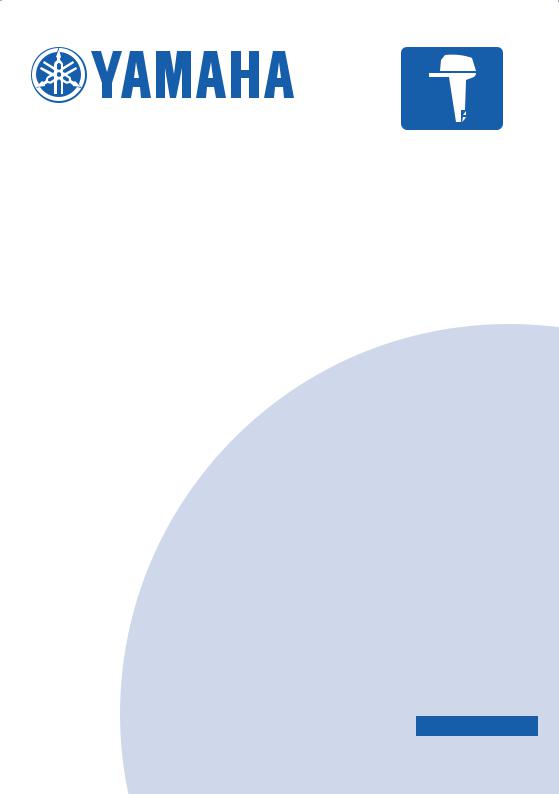
9.9D
15D
OWNER’S MANUAL
U.S.A.Edition LIT-18626-05-82 63V-28199-17

ZMU01690
Read this owner’s manual carefully before operating your outboard motor.
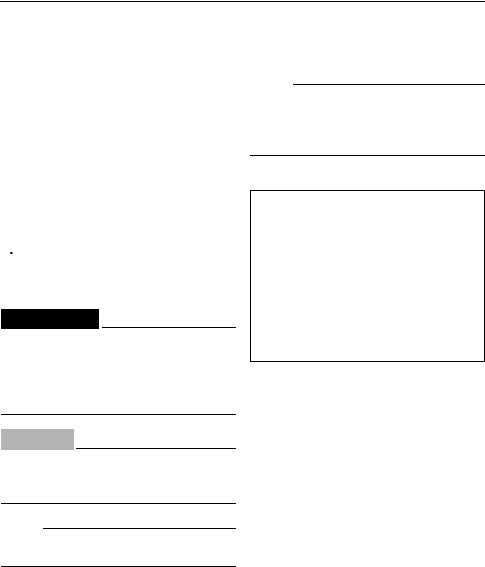
Important manual information
EMU25100
To the owner
Thank you for choosing a Yamaha outboard motor. This Owner’s Manual contains information needed for proper operation, maintenance and care. A thorough understanding of these simple instructions will help you obtain maximum enjoyment from your new Yamaha. If you have any question about the operation or maintenance of your outboard motor, please consult a Yamaha dealer.
In this Owner’s Manual particularly important information is distinguished in the following ways.
 The Safety Alert Symbol means ATTENTION! BECOME ALERT! YOUR SAFETY IS INVOLVED!
The Safety Alert Symbol means ATTENTION! BECOME ALERT! YOUR SAFETY IS INVOLVED!
EWM00780
 WARNING
WARNING
Failure to follow WARNING instructions could result in severe injury or death to the machine operator, a bystander, or a person inspecting or repairing the outboard motor.
ECM00700
CAUTION:
A CAUTION indicates special precautions that must be taken to avoid damage to the outboard motor.
NOTE:
A NOTE provides key information to make procedures easier or clearer.
Yamaha continually seeks advancements in product design and quality. Therefore, while this manual contains the most current product information available at the time of printing, there may be minor discrepancies between
your machine and this manual. If there is any question concerning this manual, please consult your Yamaha dealer.
NOTE:
The 9.9MH, 15MH and the standard accessories are used as a base for the explanations and illustrations in this manual. Therefore some items may not apply to every model.
EMU25110
9.9D, 15D OWNER’S MANUAL
©2004 by Yamaha Motor Corporation, USA
1st edition, February 2004 All rights reserved.
Any reprinting or unauthorized use without the written permission of Yamaha Motor Corporation, USA is expressly prohibited.
Printed in Japan
P/N LIT-18626-05-82

Table of contents
General information ...................... |
1 |
Identification numbers record ...... |
1 |
Outboard motor serial number ....... |
1 |
Emission control information ....... |
1 |
North American models.................. |
1 |
Safety information ....................... |
2 |
Important labels........................... |
3 |
Warning labels................................ |
3 |
Basic boating rules |
|
(Rules of the road) ................... |
3 |
Steering and sailing rules and |
|
sound signals .............................. |
3 |
Rules when encountering |
|
vessels ........................................ |
4 |
Other special situations .................. |
5 |
Fueling instructions ..................... |
7 |
Gasoline ......................................... |
8 |
Engine oil........................................ |
8 |
Propeller selection....................... |
8 |
Start-in-gear protection ............... |
9 |
Basic components ...................... |
10 |
Main components...................... |
10 |
Fuel tank....................................... |
10 |
Fuel joint....................................... |
11 |
Fuel gauge ................................... |
11 |
Fuel tank cap................................ |
11 |
Air vent screw............................... |
11 |
Tiller handle.................................. |
11 |
Gear shift lever ............................. |
11 |
Throttle grip .................................. |
11 |
Throttle indicator........................... |
12 |
Throttle friction adjuster................ |
12 |
Engine stop lanyard switch........... |
12 |
Engine stop button ....................... |
13 |
Choke knob .................................. |
13 |
Manual starter handle................... |
13 |
Steering friction adjuster............... |
13 |
Trim rod (tilt pin) ........................... |
14 |
Tilt lock mechanism...................... |
14 |
Tilt support bar ............................. |
14 |
Top cowling lock lever(s) |
|
(turn type).................................. |
14 |
Carrying handle ............................ |
15 |
Operation ..................................... |
16 |
Installation................................. |
16 |
Mounting the outboard motor ....... |
16 |
Clamping the outboard motor ....... |
17 |
Breaking in engine .................... |
18 |
Gasoline and engine oil mixing |
|
chart (25:1)................................ |
18 |
Procedure for pre-mixed |
|
models ...................................... |
18 |
Preoperation checks ................. |
19 |
Fuel .............................................. |
19 |
Oil ................................................. |
19 |
Controls ........................................ |
19 |
Engine .......................................... |
19 |
Filling fuel and engine oil .......... |
19 |
Filling fuel for portable tank .......... |
19 |
Ring Free Fuel Additive ................ |
19 |
Gasoline and oil mixing (100:1) .... |
20 |
Operating engine ...................... |
21 |
Feeding fuel (portable tank) ......... |
21 |
Starting engine ............................. |
22 |
Warming up engine................... |
23 |
Choke start models ...................... |
23 |
Shifting ...................................... |
24 |
Forward (tiller handle and |
|
remote control models) ............. |
24 |
Reverse (manual tilt and |
|
hydro tilt models)....................... |
24 |
Stopping engine ........................ |
25 |
Procedure..................................... |
25 |
Trimming outboard motor.......... |
26 |
Adjusting trim angle for |
|
manual tilt models ..................... |
26 |
Adjusting boat trim........................ |
27 |
Tilting up and down................... |
28 |
Procedure for tilting up |
|
(manual tilt models)................... |
28 |
Procedure for tilting down |
|
(manual tilt models)................... |
29 |
Cruising in shallow water .......... |
29 |
Cruising in shallow water |
|
(manual tilt models)................... |
29 |

Table of contents
Cruising in other conditions ....... |
31 |
Maintenance................................. |
32 |
Specifications ............................ |
32 |
Transporting and storing |
|
outboard motor....................... |
32 |
Clamp screw mounting models .... |
33 |
Storing outboard motor................. |
33 |
Procedure..................................... |
33 |
Lubrication |
|
(except oil injection models)...... |
35 |
Cleaning and anticorrosion |
|
measures .................................. |
35 |
Cleaning the outboard motor........ |
35 |
Checking painted surface of |
|
motor......................................... |
35 |
Periodic maintenance................ |
35 |
Replacement parts ....................... |
35 |
Maintenance chart........................ |
36 |
Greasing....................................... |
37 |
Cleaning and adjusting |
|
spark plug ................................. |
37 |
Checking fuel system ................... |
38 |
Inspecting fuel filter ...................... |
39 |
Cleaning fuel filter......................... |
39 |
Inspecting idling speed................. |
39 |
Checking wiring and |
|
connectors ................................ |
40 |
Exhaust leakage........................... |
40 |
Water leakage .............................. |
40 |
Checking propeller ....................... |
40 |
Removing the propeller ................ |
41 |
Installing the propeller .................. |
41 |
Changing gear oil ......................... |
42 |
Cleaning fuel tank......................... |
43 |
Inspecting and replacing |
|
anode(s).................................... |
43 |
Checking top cowling ................... |
44 |
Coating the boat bottom ............... |
44 |
Trouble Recovery ........................ |
45 |
Troubleshooting ........................ |
45 |
Temporary action in |
|
emergency ............................. |
48 |
Impact damage............................. |
48 |
Starter will not operate ................. |
48 |
Emergency starting engine........... |
49 |
Treatment of submerged |
|
motor...................................... |
50 |
Procedure..................................... |
50 |
Consumer information ............... |
51 |
Important warranty information |
|
for U.S.A. and Canada........... |
51 |
YAMAHA MOTOR |
|
CORPORATION, U.S.A. |
|
OUTBOARD MOTOR |
|
TWO YEAR LIMITED |
|
WARRANTY .......................... |
53 |
IMPORTANT WARRANTY |
|
INFORMATION IF YOU USE |
|
YOUR YAMAHA OUTSIDE |
|
U.S.A. OR CANADA .............. |
56 |
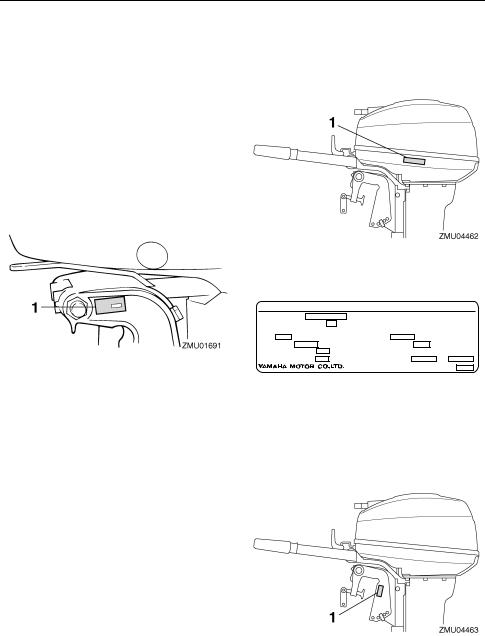
General information
EMU25170
Identification numbers record
EMU25182
Outboard motor serial number
The outboard motor serial number is stamped on the label attached to the port side of the clamp bracket or the upper part of the swivel bracket.
Record your outboard motor serial number in the spaces provided to assist you in ordering spare parts from your Yamaha dealer or for reference in case your outboard motor is stolen.
1. Outboard motor serial number location
EMU25220
Emission control information
EMU25230
North American models
This engine conforms to U.S. Environmental Protection Agency (EPA) regulations for marine SI engines. See the label affixed to your engine for details.
EMU30390
Approval label of emission control certificate
This label is attached to the bottom cowling. Existing Technology; N/A
1. Approval label location
EMISSION CONTROL INFORMATION
ENGINE FAMILY :
THIS ENGINE CONFORMS TO 2001 U.S. EPA REGULATIONS FOR MARINE SI ENGINES. REFER TO THE OWNERS MANUAL FOR MAINTENANCE SPECIFICATIONS AND ADJUSTMENTS.
FELs : |
g/kw-hr |
|
|
IDLE SPEED : |
rpm IN NEUTRAL |
SPARK PLUG : |
|
|
|
SPARK PLUG GAP (mm) : |
|
DISPLACEMENT : |
cm |
3 |
FUEL : GASOLINE |
|
|
ADVERTISED POWER : |
kw |
|
VALVE LASH (mm) : IN |
EX |
|
ZMU04304
EMU25261
Manufactured date label
This label is attached to the clamp bracket or the swivel bracket.
1. Manufactured date label location
1
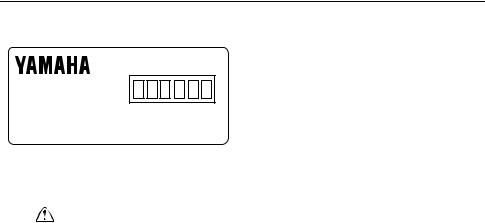
General information
Manufactured:
ZMU04346
EMU25361
Safety information
●Before mounting or operating the outboard motor, read this entire manual. Reading it should give you an understanding of the motor and its operation.
●Before operating the boat, read any owner’s or operator’s manuals supplied with it and all labels. Be sure you understand each item before operating.
●Do not overpower the boat with this outboard motor. Overpowering the boat could result in loss of control. The rated power of the outboard should be equal to or less than the rated horsepower capacity of the boat. If the rated horsepower capacity of the boat is unknown, consult the dealer or boat manufacturer.
●Do not modify the outboard. Modifications could make the motor unfit or unsafe to use.
●Never operate after drinking alcohol or taking drugs. About 50% of all boating fatalities involve intoxication.
●Have an approved personal flotation device (PFD) on board for every occupant. It is a good idea to wear a PFD whenever boating. At a minimum, children and non-swim- mers should always wear PFDs, and
everyone should wear PFDs when there are potentially hazardous boating conditions.
●Gasoline is highly flammable, and its vapors are flammable and explosive. Handle and store gasoline carefully. Make sure there are no gas fumes or leaking fuel before starting the engine.
●This product emits exhaust gases which contain carbon monoxide, a colorless, odorless gas which may cause brain damage or death when inhaled. Symptoms include nausea, dizziness, and drowsiness. Keep cockpit and cabin areas well ventilated. Avoid blocking exhaust outlets.
●Check throttle, shift, and steering for proper operation before starting the engine.
●Attach the engine stop switch lanyard cord to a secure place on your clothing, or your arm or leg while operating. If you accidentally leave the helm, the cord will pull from the switch, stopping the engine.
●Know the marine laws and regulations where you will be boating—and obey them. For basic boating rules, see “Rules of the road” on page 3.
●Stay informed about the weather. Check weather forecasts before boating. Avoid boating in hazardous weather.
●Tell someone where you are going: leave a Float Plan with a responsible person. Be sure to cancel the Float Plan when you return.
●Use common sense and good judgment when boating. Know your abilities, and be sure you understand how your boat handles under the different boating conditions you may encounter. Operate within your limits, and the limits of your boat. Always operate at safe speeds, and keep a careful watch for obstacles and other traffic.
2

General information
●Always watch carefully for swimmers during the engine operation.
●Stay away from swimming areas.
●When a swimmer is in the water near you
shift into neutral and shut off the engine. Be informed about boating safety. Additional publications and information can be obtained from many organizations, including the following:
United States Coast Guard
Consumer Affairs Staff (G-BC)
Office of Boating, Public, and Consumer Affairs
U.S. Coast Guard Headquarters
Washington, D.C. 20593-0001
Boating Safety Hotline: 1-800-368-5647
National Marine Manufacturers Association (NMMA)
401 N. Michigan Ave. Chicago, Il 60611
Marine Retailers Association of America
155 N. Michigan Ave. Chicago, Il 60601
EMU25380
Important labels
EMU25395
Warning labels
EMU25401
Label
EWM01260
 WARNING
WARNING
●Be sure shift control is in neutral before starting engine. (except 2HP)
●Do not touch or remove electrical parts when starting or during operation.
●Keep hands, hair, and clothes away from flywheel and other rotating parts while engine is running.
EMU25431
Label
EWM01300
 WARNING
WARNING
●This engine is equipped with a neutral starting device.
●The engine will not start unless the shift control is in neutral position.
EMU25500
Basic boating rules (Rules of the road)
Just as there are rules which apply when you are driving on streets and high ways, there are waterway rules which apply when you are driving your boat. These rules are used internationally, and are also enforced by the United States Coast Guard and local agencies. You should be aware of these rules, and follow them whenever you encounter another vessel on the water.
Several sets of rules prevail according to geographic location, but are all basically the same as the International Rules of the Road. The rules presented here in your Owner’s Manual are condensed, and have been provided for your convenience only. Consult your local U.S. Coast Guard Auxiliary or Department of Motor Vehicles for a complete set of rules governing the waters in which you will be using your boat.
EMU25510
Steering and sailing rules and sound signals
Whenever two vessels on the water meet one another, one vessel has the right-of-way; it is called the “stand-on” vessel. The vessel
3
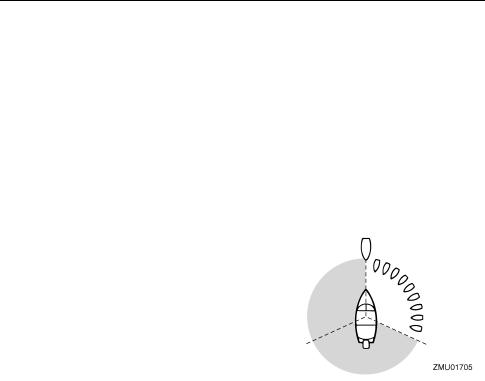
General information
which does not have the right-of-way is called the “give-way” or “burdened” vessel. These rules determine which vessel has the right-of- way, and what each vessel should do.
Stand-on vessel
The vessel with the right-of-way has the duty to continue its course and speed, except to avoid an immediate collision. When you maintain your direction and speed, the other vessel will be able to determine how best to avoid you.
Give-way vessel
The vessel which does not have the right-of- way has the duty to take positive and timely action to stay out of the way of the Stand-On vessel. Normally, you should not cross in front of the vessel with the right-of-way. You should slow down or change directions briefly and pass behind the other vessel. You should always move in such a way that the operator of the other vessel can see what you are doing.
“The general prudential rule”
This rule is called Rule 2 in the International Rules and says,
“In obeying and construing these rules due regard shall be had to all dangers of navigation and collision, and to any special circumstances, which may render a departure from the above rules necessary in order to avoid immediate danger.”
In other words, follow the standard rules except when a collision will occur unless both vessels try to avoid each other. If that is the case, both vessels become “Give-Way” vessels.
EMU25520
Rules when encountering vessels
There are three main situations which you may encounter with other vessels which could lead to a collision unless the Steering Rules are followed:
Meeting: (you are approaching another vessel head-on)
Crossing: (you are traveling across the other vessel’s path)
Overtaking: (you are passing or being passed by another vessel)
In the following illustration, your boat is in the center. You should give the right-of-way to any vessels shown in white area (you are the Give-Way vessel). Any vessels in the shaded area must yield to you (they are the Give-Way vessels). Both you and the meeting vessel must alter course to avoid each other.
Meeting
If you are meeting another power vessel head on, and are close enough to run the risk of collision, neither of you has the right-of-way! Both of you should alter course to avoid an accident. You should keep the other vessel on your port (left) side. This rule doesn’t apply if both of you will clear one another if you continue on your set course and speed.
4
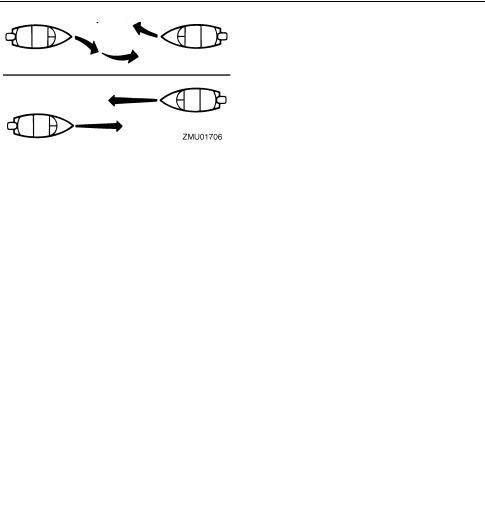
General information
Crossing
When two power driven vessels are crossing each other’s path close enough to run the risk of collision, the vessel which has the other on the starboard (right) side must keep out of the way of the other. If the other vessel is on your right, you must keep out of its way; you are the Give-Way vessel. If the other vessel is on your port (left) side, remember that you should maintain course and direction, provided the other vessel gives you the right-of-way as it should.
Overtaking
If you are passing another vessel, you are the “Give-Way” vessel. This means that the other vessel is expected to maintain its course and speed. You must stay out of its way until you are clear of it. Likewise, if another vessel is passing you, you should maintain your speed and direction so that the other vessel can steer itself around you.
EMU25530
Other special situations
There are three other rules you should be aware of when driving your boat around other vessels.
Narrow channels and bends
When navigating in narrow channels, you should keep to the right when it is safe and practical to do so. If the operator of a powerdriven vessel is preparing to go around a bend that may obstruct the view of other water vessels, the operator should sound a prolonged blast on the whistle (4 to 6 seconds). If another vessel is around the bend, it too should sound the whistle. Even if no reply is heard, however, the vessel should still proceed around the bend with caution. If you navigate such waters with your boat, you will need to carry a portable air horn, available from local marine supply stores.
Fishing vessel right-of-way
All vessels which are fishing with nets, lines or trawls are considered to be “fishing vessels” under the International Rules. Vessels with trolling lines are not considered fishing vessels. Fishing vessels have the right-of-way regardless of position. Fishing vessels cannot, however, impede the passage of other vessels in narrow channels.
Sailing vessel right-of-way
Sailing vessels should normally be given the right-of-way. The exceptions to this are:
1.When the sailing vessel is overtaking the power-driven vessel, the power-driven vessel has the right-of-way.
2.Sailing vessels should keep clear of any fishing vessel.
3.In a narrow channel, a sailing vessel should not hamper the safe passage of a power-driven vessel which can navigate only in such a channel.
5

General information
Reading buoys and other markers
The waters of the United states are marked for safe navigation by the lateral system of buoyage. Simply put, buoys and markers have an arrangement of shapes, colors, numbers and lights to show which side of the buoy a boater should pass on when navigating in a particular direction. The markings on these buoys are oriented from the perspective of being entered from seaward (the boater is going towards the port). This means that red buoys are passed on the starboard (right) side when proceeding from open water into port, and black buoys are to port (left) side. When navigating out of port, your position with respect to the buoys should be reversed; red buoys should be to port and black buoys to starboard.
Many bodies of water used by boaters are entirely within the boundaries of a particular state. The Uniform State Waterway Marking System has been devised for these waters. This system uses buoys and signs with distinctive shapes and colors to show regulatory or advisory information. These markers are white with black letters and orange boarders. They signify speed zones, restricted areas, danger areas, and general information.
Remember, markings may vary by geographic location. Always consult local boating authorities before driving your boat in unfamiliar waters.
6
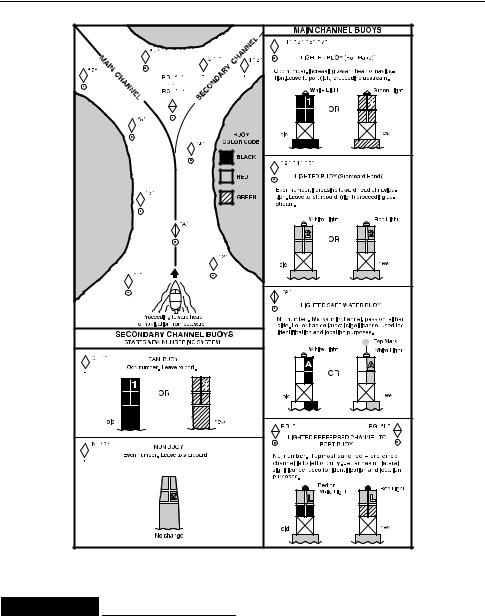
General information
ZMU01708 |
EMU25540
Fueling instructions
EWM00010
 WARNING
WARNING
GASOLINE AND ITS VAPORS ARE HIGHLY FLAMMABLE AND EXPLOSIVE!
●Do not smoke when refueling, and keep away from sparks, flames, or other sources of ignition.
●Stop engine before refueling.
●Refuel in a well-ventilated area. Refuel portable fuel tanks off the boat.
7
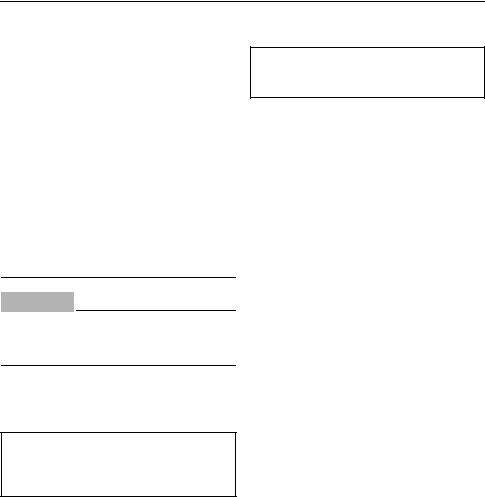
General information
●Take care not to spill gasoline. If gasoline spills, wipe it up immediately with dry rags.
●Do not overfill the fuel tank.
●Tighten the filler cap securely after refueling.
●If you should swallow some gasoline, inhale a lot of gasoline vapor, or get gasoline in your eyes, get immediate medical attention.
●If any gasoline spills onto your skin, immediately wash with soap and water. Change clothing if gasoline spills on it.
●Touch the fuel nozzle to the filler opening or funnel to help prevent electrostatic sparks.
ECM00010
CAUTION:
Use only new clean gasoline which has been stored in clean containers and is not contaminated with water or foreign matter.
EMU25570
Gasoline
If knocking or pinging occurs, use a different brand of gasoline or premium unleaded fuel.
Recommended gasoline:
Regular unleaded gasoline with a minimum octane rating of 86 (Pump Octane Number) = (R+M)/2
Gasohol
There are two types of gasohol: gasohol containing ethanol and that containing methanol. Gasohol containing ethanol can be used if ethanol content does not exceed 10% and the fuel meets minimum octane ratings. Yamaha does not recommended gasohol containing methanol because it can cause fuel system damage or engine performance problems.
EMU25650
Engine oil
Recommended engine oil: YAMALUBE 2-stroke outboard motor oil
If the recommended engine oil is not available, another 2-stroke engine oil with an NMMA-certified TC-W3 rating may be used.
EMU25741
Propeller selection
The performance of your outboard motor will be critically affected by your choice of propeller, as an incorrect choice could adversely affect performance and could also seriously damage the motor. Engine speed depends on the propeller size and boat load. If engine speed is too high or too low for good engine performance, this will have an adverse effect on the engine.
Yamaha outboard motors are fitted with propellers chosen to perform well over a range of applications, but there may be uses where a propeller with a different pitch would be more appropriate. For a greater operating load, a smaller-pitch propeller is more suitable as it enables the correct engine speed to be maintained. Conversely, a larger-pitch propeller is more suitable for a smaller operating load.
Yamaha dealers stock a range of propellers, and can advise you and install a propeller on your outboard that is best suited to your application.
8
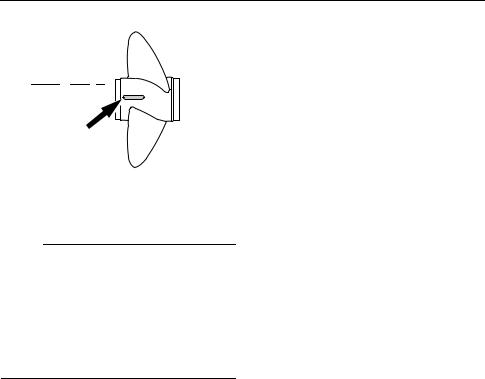
General information

 x
x -
-
 1 2 3
1 2 3
ZMU04606
1.Propeller diameter in inches
2.Propeller pitch in inches
3.Type of propeller (propeller mark)
NOTE:
Select a propeller which will allow the engine to reach the middle or upper half of the operating range at full throttle with the maximum boat load. If operating conditions such as light boat loads then allow the engine r/min to rise above the maximum recommended range, reduce the throttle setting to maintain the engine in the proper operating range.
For instructions on propeller removal and installation, see page 40.
EMU25770
Start-in-gear protection
Yamaha outboard motors or Yamaha-ap- proved remote control units are equipped with start-in-gear protection device(s). This feature permits the engine to be started only when it is in neutral. Always select neutral before starting the engine.
9
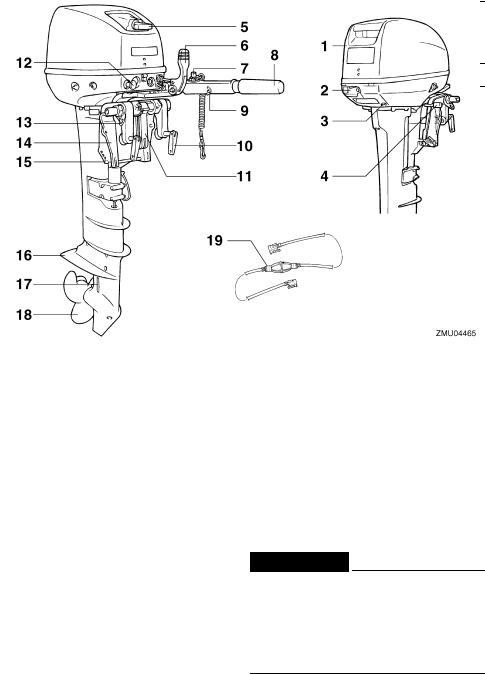
Basic components
EMU25795
Main components
NOTE:
* May not be exactly as shown; also may not be included as standard equipment on all models.
1.Top cowling
2.Top cowling lock lever
3.Cooling water pilot hole
4.Tilt lock lever
5.Manual starter handle
6.Gear shift lever
7.Engine stop button/Engine stop lanyard switch
8.Throttle grip
9.Throttle friction adjuster
10.Clamp screw 11.Carrying handle 12.Choke knob 13.Rope attachment 14.Clamp bracket 15.Trim rod 16.Anti-cavitation plate
17.Cooling water inlet 18.Propeller*
19.Fuel hose
EMU25802
Fuel tank
If your model was equipped with a portable fuel tank, its function is as follows.
EWM00020
 WARNING
WARNING
The fuel tank supplied with this engine is its dedicated fuel reservoir and must not be used as a fuel storage container. Commercial users should conform to relevant licensing or approval authority regulations.
10
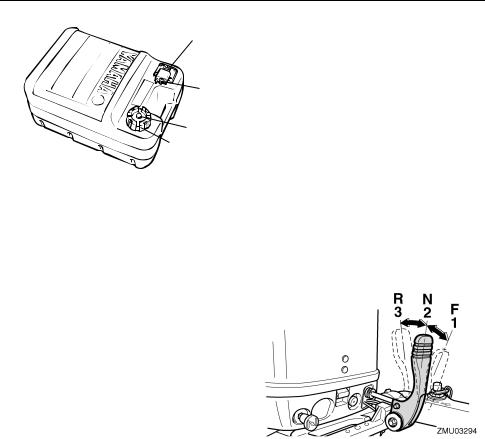
Basic components
2
1
4
3
ZMU02284
1.Fuel joint
2.Fuel gauge
3.Fuel tank cap
4.Air vent screw
EMU25830
Fuel joint
This joint is used to connect the fuel line.
EMU25841
Fuel gauge
This gauge is located on either the fuel tank cap or on the fuel joint base. It shows the approximate amount of fuel remaining in the tank.
EMU25850
Fuel tank cap
This cap seals the fuel tank. When removed, the tank can be filled with fuel. To remove the cap, turn it counterclockwise.
EMU25860
Air vent screw
This screw is on the fuel tank cap. To loosen the screw, turn it counterclockwise.
EMU25911
Tiller handle
To change direction, move the tiller handle to the left or right as necessary.
EMU25922
Gear shift lever
Pulling the gear shift lever towards you puts the engine in forward gear so that the boat moves ahead. Pushing the lever away from you puts the engine in reverse gear so that the boat moves astern.
1.Forward “ ”
”
2.Neutral “ ”
”
3.Reverse “ ”
”
EMU25941
Throttle grip
The throttle grip is on the tiller handle. Turn the grip counterclockwise to increase speed and clockwise to decrease speed.
11
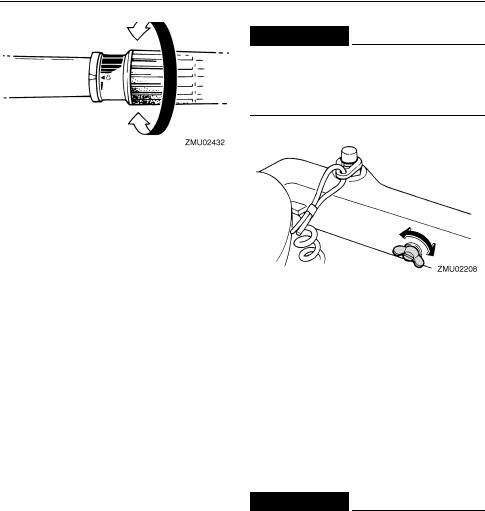
Basic components
EWM00030
 WARNING
WARNING
Do not overtighten the friction adjuster. If there is too much resistance, it could be difficult to move throttle lever or grip, which could result in an accident.
EMU25961
Throttle indicator
The fuel consumption curve on the throttle indicator shows the relative amount of fuel consumed for each throttle position. Choose the setting that offers the best performance and fuel economy for the desired operation.
1. Throttle indicator
EMU25970
Throttle friction adjuster
A friction device provides adjustable resistance to movement of the throttle grip or the remote control lever, and can be set according to operator preference.
To increase resistance, turn the adjuster clockwise. To decrease resistance, turn the adjuster counterclockwise.
When constant speed is desired, tighten the adjuster to maintain the desired throttle setting.
EMU25990
Engine stop lanyard switch
The lock plate must be attached to the engine stop switch for the engine to run. The lanyard should be attached to a secure place on the operator’s clothing, or arm or leg. Should the operator fall overboard or leave the helm, the lanyard will pull out the lock plate, stopping ignition to the engine. This will prevent the boat from running away under power.
EWM00120
 WARNING
WARNING
●Attach the engine stop switch lanyard to a secure place on your clothing, or your arm or leg while operating.
●Do not attach the lanyard to clothing that could tear loose. Do not route the lanyard where it could become entangled, preventing it from functioning.
●Avoid accidentally pulling the lanyard during normal operation. Loss of engine power means the loss of most steering
12
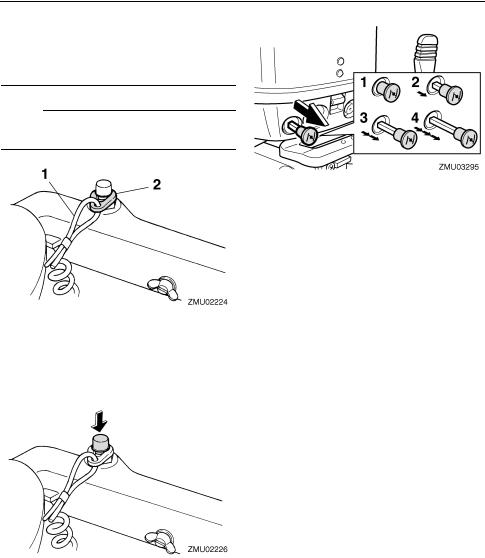
Basic components
control. Also, without engine power, the boat could slow rapidly. This could cause people and objects in the boat to be thrown forward.
NOTE:
The engine cannot be started with the lock plate removed.
1.Lanyard
2.Lock plate
EMU26001
Engine stop button
To open the ignition circuit and stop the engine, push this button.
EMU26030
Choke knob
To supply the engine with the rich fuel mixture required to start, pull out this knob. The choke knob has the 4 operating positions shown in the following illustration.
1.Use to start a hot engine
2.Use to warm up a cold engine or restart a warm engine
3.Use to warm up a cold engine or restart a warm engine
4.Use to start a cold engine
EMU26070
Manual starter handle
To start the engine, first gently pull the handle out until resistance is felt. From that position, then pull the handle straight out quickly to crank the engine.
EMU26122
Steering friction adjuster
A friction device provides adjustable resistance to the steering mechanism, and can be set according to operator preference. An adjusting screw or bolt is located on the swivel bracket.
13
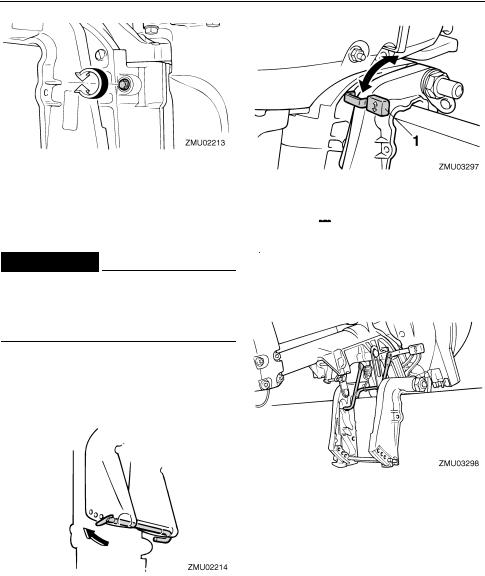
Basic components
To increase resistance, turn the adjuster clockwise.
To decrease resistance, turn the adjuster counterclockwise.
EWM00040
 WARNING
WARNING
Do not overtighten the friction adjuster. If there is too much resistance, it could be difficult to steer, which could result in an accident.
EMU26261
Trim rod (tilt pin)
The position of the trim rod determines the minimum trim angle of the outboard motor in relation to the transom.
EMU30440
Tilt lock mechanism
The tilt lock mechanism is used to prevent the outboard motor from lifting out of the water when in reverse gear.
1. Tilt lock lever
To tilt the outboard motor up, set the tilt lock lever to the “
 ” (up) position. To tilt the outboard motor down, set the tilt lock lever to the “
” (up) position. To tilt the outboard motor down, set the tilt lock lever to the “
 ” (down) position.
” (down) position.
EMU26330
Tilt support bar
The tilt support bar keeps the outboard motor in the tilted up position.
EMU26372
Top cowling lock lever(s) (turn type)
To remove the engine top cowling, turn the lock lever(s) and lift off the cowling. When installing the cowling, check to be sure it fits properly in the rubber seal. Then lock the cowling again by returning the lever(s) to the lock position.
14
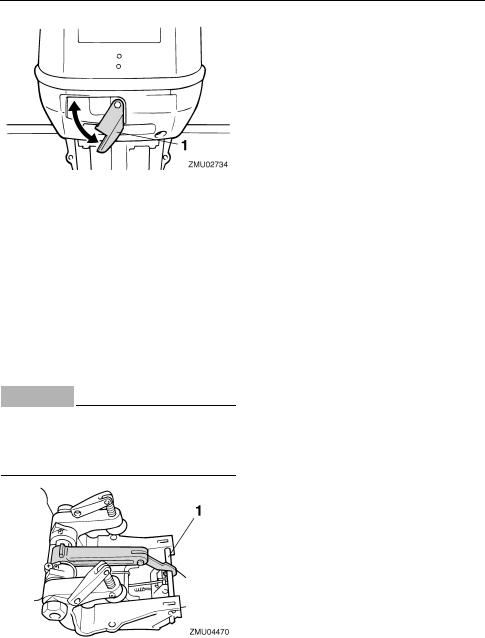
Basic components
1. Top cowling lock lever(s)
EMU26430
Carrying handle
A carrying handle is included on the clamp bracket. After setting the handle up, it enables you to carry the outboard motor easily with one hand.
To set up the carrying handle, proceed as follows:
1.Place the tilt lock lever in the lock position.
2.Securely hook the arm on the carrying
handle end to the clamp bracket bar.
ECM00080
CAUTION:
Place the tilt lock lever in the lock position while using the carrying handle. Otherwise, the lower unit could fall to the ground while carrying the motor.
1. Clamp bracket bar
15
